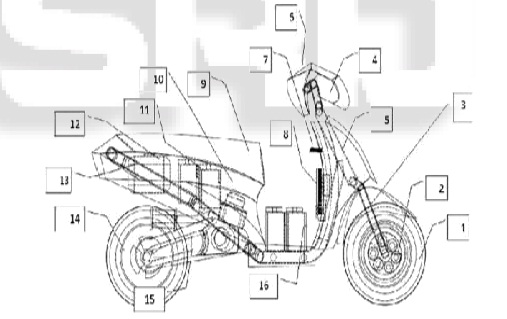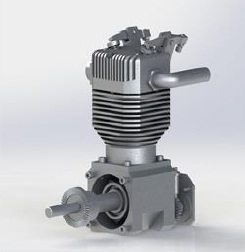





Published on Apr 02, 2024
A Hybrid electric vehicle is a vehicle which relies not only on batteries but also on an internal combustion engine which drives a generator to provide the electricity and may also drive a wheel. It has great advantages over the previously used gasoline engine that drives the power from gasoline only.
It is a major source of air pollution. The objective is to design and fabricate a two wheeler hybrid electric vehicle powered by both battery and gasoline (PETROL). The combination of both the power makes the vehicle dynamic in nature over conventional automobiles.
Hybrid electric vehicles combine an electric motor, battery and power system with an internal combustion engine to achieve better fuel economy and reduce toxic emissions. Equipment and their cost analysis are done. It deals with the fabrication of the vehicle. The final stage would consist of increasing the efficiency of the vehicle in economic ways.
Around 93% of today‟s automobiles run on petroleum based product, which are estimated to be depleted by 2050. Moreover, current automobiles utilize only 25% of the energy released from petroleum and rest is wasted into the atmosphere. For preservation of gasoline for future and increasing the efficiency of vehicle an electric vehicle can be a major breakthrough. An electric vehicle is pollution free and is efficient at low speed conditions mainly in high traffic areas. But battery charging is time consuming. Gasoline engine proves its efficiency at higher speeds in high ways and waste a lot of energy in urban areas. A hybrid vehicle solves these problems by combining the advantages of both the systems and uses both the power sources at their efficient conditions.
The objective of this project aims at better utilization of fuel energy and reduces dependence on non-renewable resources using latest technology. The implementation involves development of HEV that uses battery as well as gasoline power for propulsion of vehicle. A 'gasoline-electric hybrid vehicle' is an automobile which relies not only on gasoline but also on electric power source. In HEV, the battery alone provides power for low-speed driving conditions. During long highways or hill climbing, the gasoline engine drives the vehicle solely. Hybrid electric vehicles comprise of an electric motor, inverter, battery as electric drive and an internal combustion engine with transmission connected as gasoline based drive. It has great advantages over the previously used gasoline engine that is driven solely from gasoline. This hybrid combination makes the vehicle dynamic in nature and provides its owner a better fuel economy and lesser environmental impact over conventional automobile.
The work discloses a hybrid system consisting of an Electric and Internal Combustion(IC) based power drives. The front wheel is being propelled by battery and the rear wheel is powered by gasoline, i.e, it includes a single cylinder, air cooled internal combustion engine and a BLDC motor based electric power drive used for hybrid powering of the vehicle. The controller is designed to implement the switching between IC Engine and Electric motor depending on the power requirement and load conditions.

1)Tyre
2)Hub Motor
3)Suspension
4)Headlamp
5) Body Cover
6)Display
7)Microcontroller
8) Hub Motor Controller
9)Seat
10)Engine
11)Front Battery
12)Fuel Tank
13)Chassis
14)RearTyre
15)Transmission
16)Rear Battery
The vehicle at lower speed act as front wheel drive and at high speed gets switched to rear wheel drive automatically. Component 1 in Fig 7 shows the attachment of tyre with the hub motor (2). There is no need for any gear reduction since the torque produced is sufficient enough to drive the vehicle. The axel of the motor is connected to the suspension (3). Suspension is connected to the handle which is connected to the main chassis. Accessories such as headlamp (4), display (6) are included as user aid. A microcontroller (7) powered up from battery, performs the switching from electric to internal combustion or vice versa as per the requirement. It senses throttle position and controls the hub motor speed via controller circuit and the IC Engine via servo motor to control speed of rear wheel.
Due to space constraints, two batteries (16) are placed in front and two are placed near the fuel tank. Engine (10) is connected to the main chassis and seat (9) is situated above the engine. CVT is connected to the crank shaft of the engine to avoid any shocks while switching and it makes the controlling simpler and easier. In HEV, the battery alone provides power for low-speed driving conditions where internal combustion engines are least efficient. In accelerating, passing, or hill climbing where high power is required battery provides power to electric motor as an additional power to assist the engine.
This allows a smaller, more efficient engine to be used. A throttle position sensor (TPS) is a sensor used to monitor the position of the throttle in an internal combustion engine. It consists of a hall sensor. When the accelerator throttle angle changes magnetic field is created and it creates voltage across position sensor terminal. Thus for various angles, various voltages are obtained.

HEV consists of a throttle position sensor, i.e, hall sensor. It gives voltage as output with respect to the angle displacement in the accelerator. The analog voltage generated is converted to digital through ADC and is given to microcontroller. If the speed corresponding to the angle deviation in accelerator is less than 30km/hr then the relay is switched on. The relay switching completes the circuit of the battery, inverter and hub motor; and vehicle is motioned by electric power. If the speed directed by accelerator is greater than 30km/hr, then the engine is started by closing the circuit of starting motor through a relay. The starting motor circuit is activated for five hundred milliseconds such that the vehicle is started. Once the vehicle starts the valve of engine for gasoline intake opens by servo motor. The amount of opening is controlled by the PWM generated by the microcontroller as directed by the accelerator.
HEV is a vehicle that uses two sources of power- gasoline and battery. For low power application battery drive is used whereas for high power application where power requirement is very high gasoline engine is used. Gasoline drive is most efficient at high speed drive. Thus HEV‟s both mode of operation occurs at their maximum efficiency. But in gasoline engine low speed operation is not efficient. Its high speed mode is only efficient. Therefore, it gives twice the mileage given by a normal vehicle. As this hybrid vehicle emits 50% less emission than normal vehicle it plays an important role for reducing pollution to certain extent without compromising with efficiency.
Thus it is most efficient in urban areas mainly in high traffic where gasoline engines are least efficient as the energy from gasoline is being wasted away and creates pollution. The current society mostly depends on petroleum as the major source power for vehicle propulsion. The electric vehicle is not very efficient for all power conditions, i.e, it cannot provide power for high speed conditions. Through the project a hybrid method of both the vehicles is proposed which utilizes the efficiency of both the vehicles. This method is implemented in two-wheeled vehicles that are mostly preferred by public. Thus proper manufacturing and cost analysis can make the vehicle a major breakthrough.
[1] R. Prabhakar, S. J. Citron, and R. E. Goodson “Optimization of Automobile Engine Fuel Economy and Emissions.” ASME Paper 75-WAlAut-19, Dec. 1975.
[2] J. A. Cook and B. K. Powell. “Discrete Simplified External Linearization and Analytical Comparison of IC Engine Families,” Proc. 1987Amer. Conrr. Con$, vol.1, pp. 326-330, June 1987.
[3] C. Kricke and S. Hagel, “A hybrid electric vehicle simulation model for component design and energy management optimization,” in Proc. FISITA World Automotive Congress, Paris, France, Sept. 1998.
[4] M. Ehsani, K. M. Rahman, and H. A. Toliyat, “Propulsion system design of electric and hybrid vehicles,” IEEE Trans. Ind. Electron., vol. 44, pp. 19–27, Feb. 1997.
| Are you interested in this topic.Then mail to us immediately to get the full report.
email :- contactv2@gmail.com |